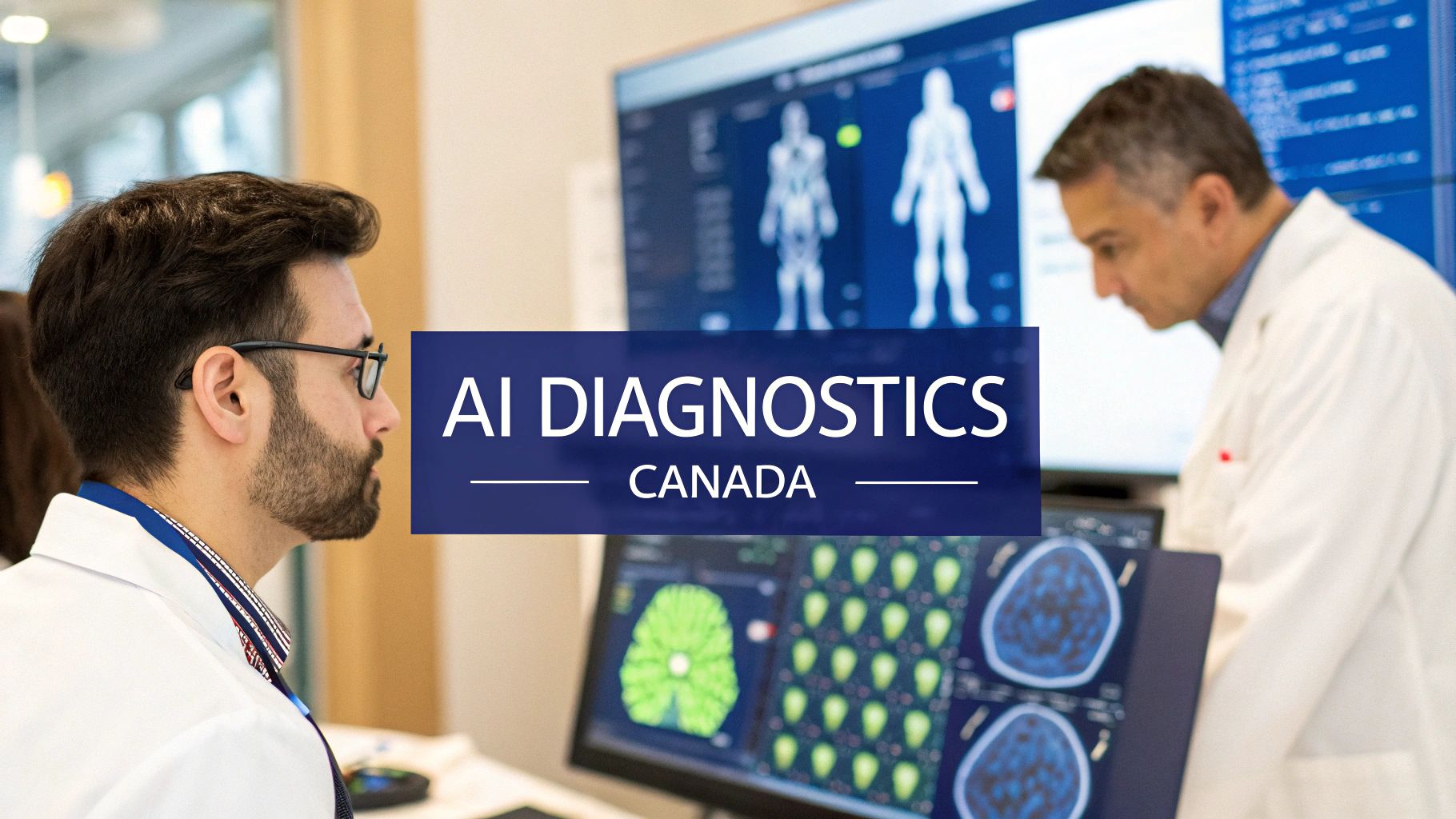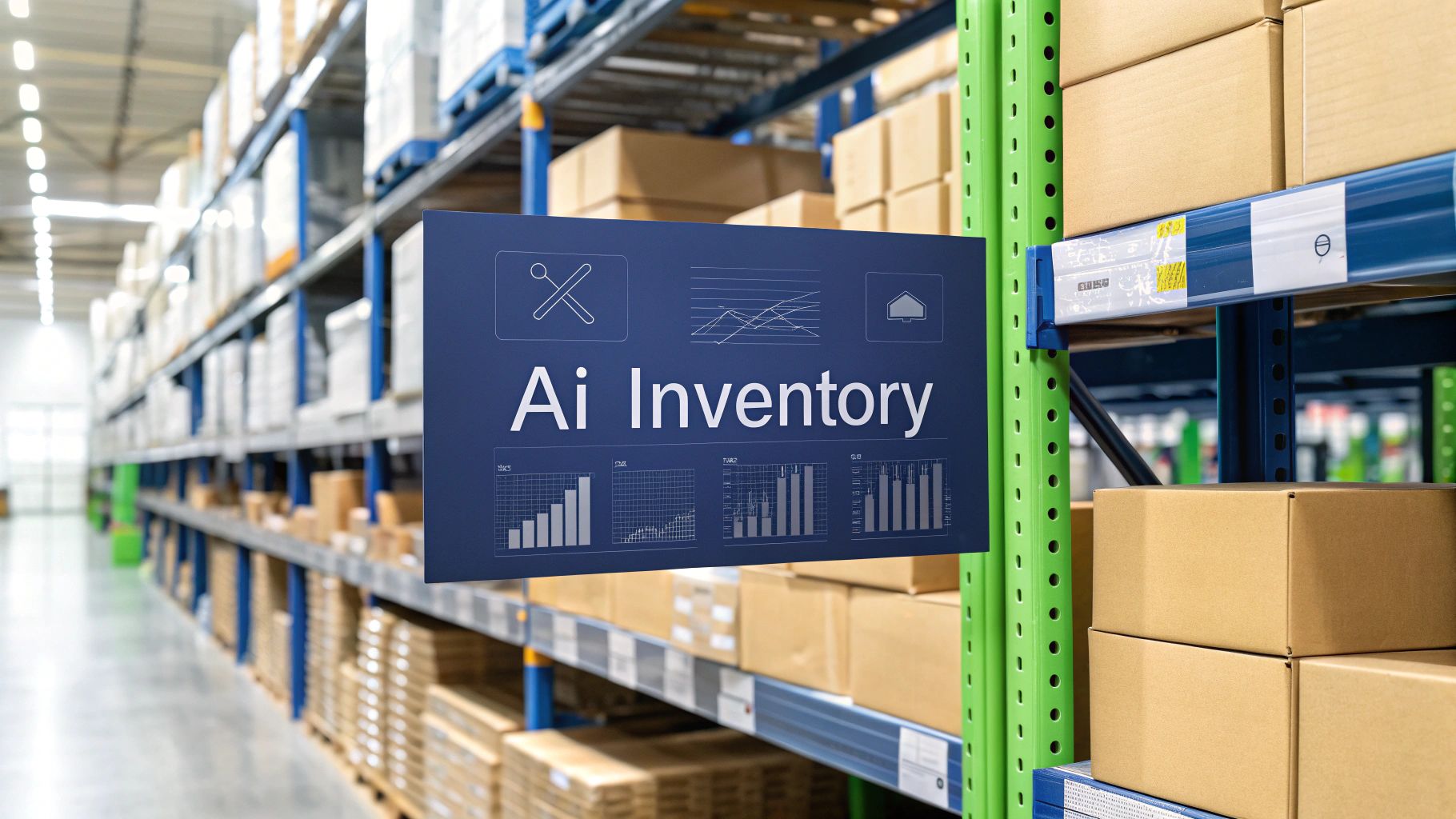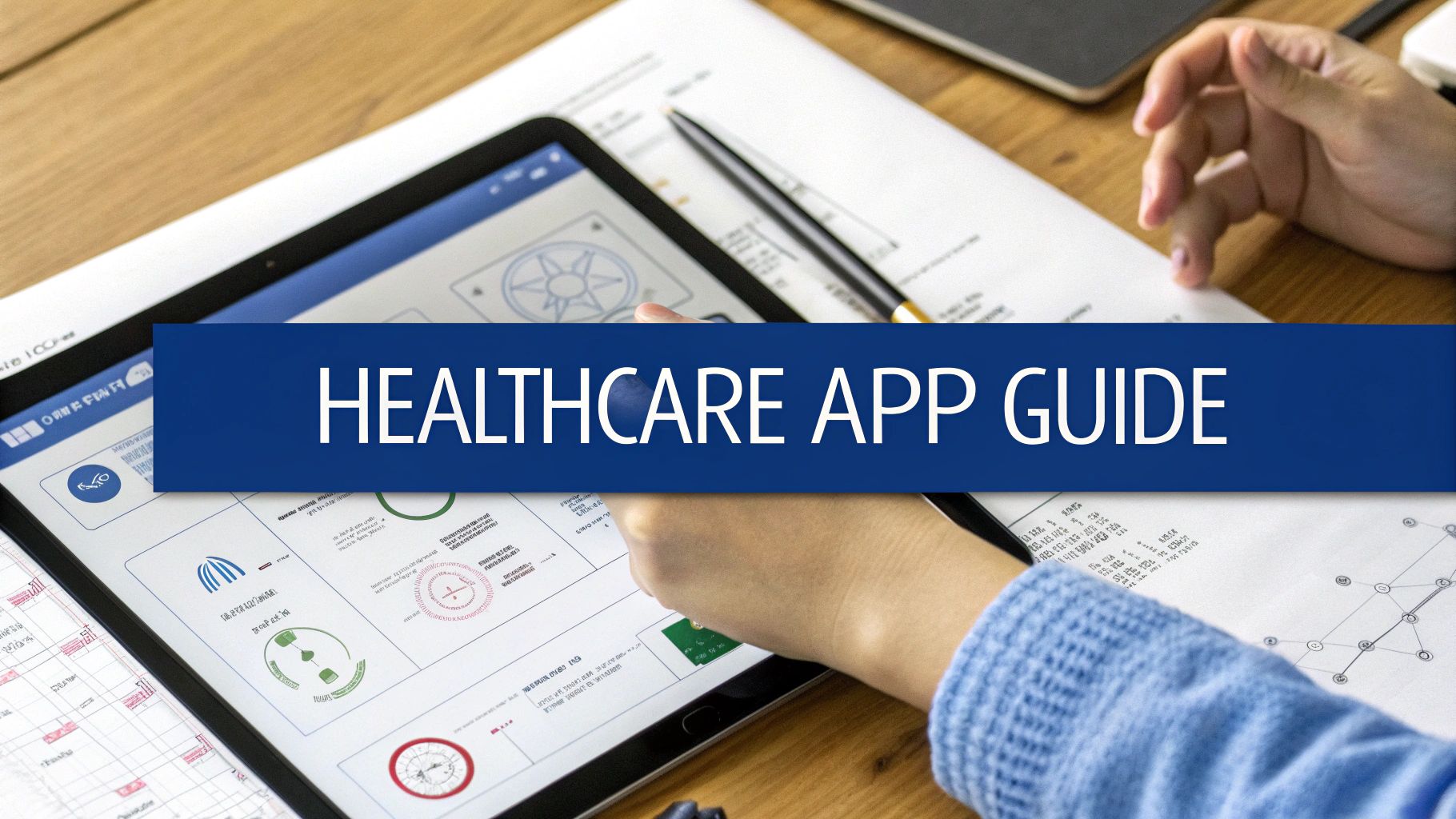Picture this: a medical expert with the ability to pore over millions of scans and patient reports in mere minutes, identifying subtle patterns that even a trained human eye might miss. This isn't science fiction. It's the core promise of AI diagnostics in Canada, a field rapidly shifting from a futuristic concept into a practical reality in clinics and hospitals across the country.
The New Frontier of AI Diagnostics in Canada
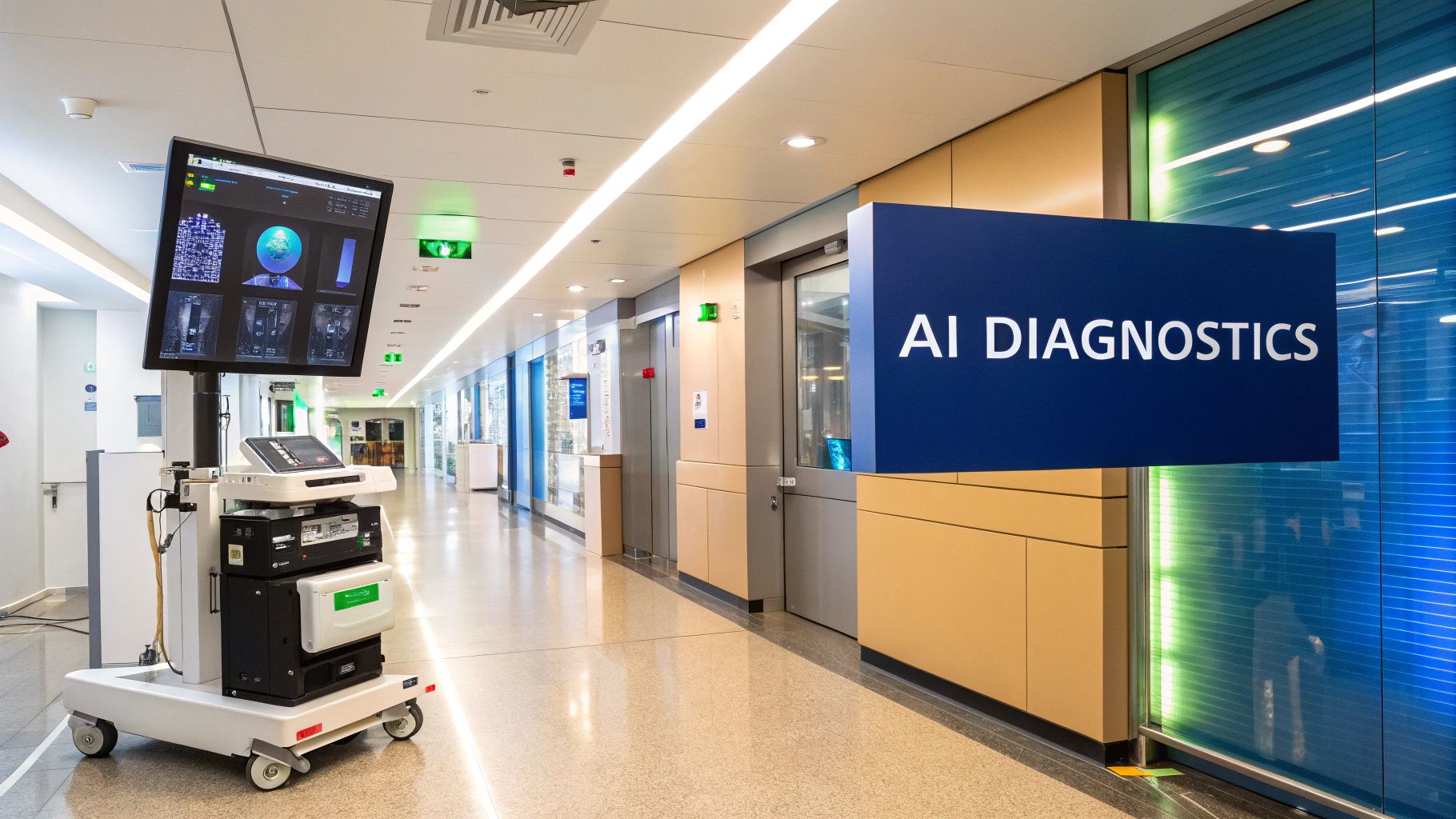
Let’s be clear: artificial intelligence in diagnostics isn't about replacing doctors. It's about empowering them with exceptionally powerful tools. Think of it as a highly skilled partner, one that can sift through enormous volumes of medical data, from MRIs and CT scans to pathology slides and lab results, with incredible speed and precision. This capability is fundamentally changing how patient care is delivered, from coast to coast.
This shift is happening now because a few key things have aligned. Canada's world-class AI research hubs, paired with a healthcare system actively looking for new efficiencies, have created the perfect incubator for these technologies to grow. The collective goal is to tackle some of our most significant healthcare challenges head-on.
Key Drivers Behind the AI Shift
The move towards AI diagnostics in Canada isn't just happening for the sake of technology; it's fuelled by real needs and major advancements. These drivers are solving tangible problems within our current healthcare system.
-
Addressing Diagnostic Delays: AI algorithms can analyze medical images 24/7, which helps cut down on backlogs and shorten the anxious wait times patients face for critical diagnoses. For example, an AI could pre-screen thousands of chest X-rays, flagging the most urgent cases for immediate review by a radiologist.
-
Improving Accuracy and Early Detection: By training on vast datasets of past cases, AI models learn to spot the faintest signs of disease that could otherwise be missed. This is a game-changer in fields like oncology and neurology, where finding something early can completely alter a patient's outcome.
-
Enhancing Healthcare Efficiency: When you automate the repetitive, data-heavy analytical tasks, you free up highly trained medical professionals to focus on what they do best: handling complex cases and spending quality time with patients. It's all about making better use of our invaluable human expertise.
AI diagnostics represents a significant step towards a more proactive and personalized model of healthcare. By pulling deeper insights from the data we already have, these tools help clinicians make better-informed decisions, faster. Ultimately, that leads to better care for all Canadians.
This is your starting point for getting to grips with one of the most important developments in modern Canadian medicine. From here, we'll dive into how this technology actually works, see where it's already being used, and understand the regulatory framework that's guiding its safe and responsible rollout.
How AI is Changing the Game in Medical Diagnosis
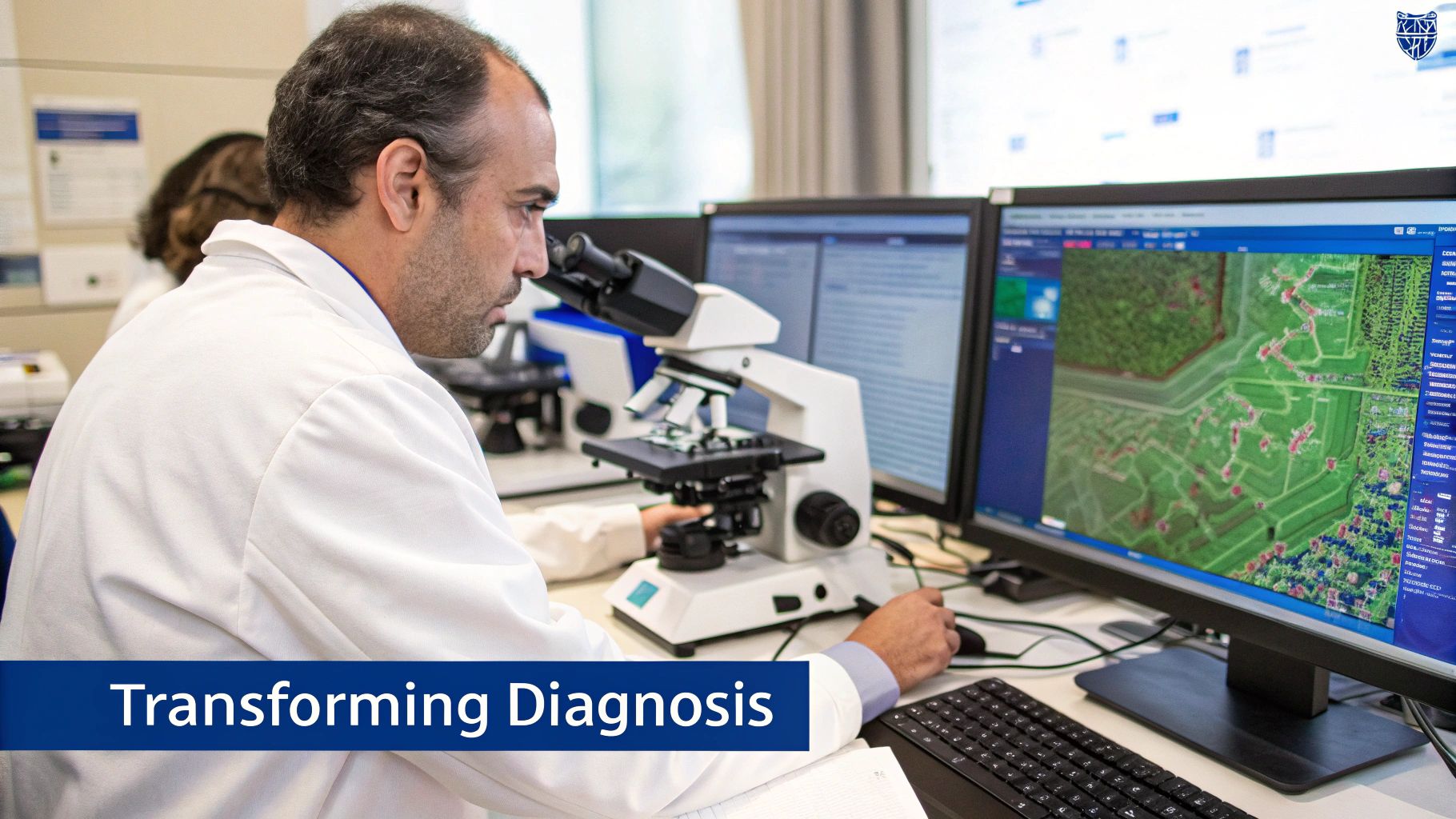
To really get a handle on what AI is doing for healthcare, we need to peek under the hood. At its core, AI diagnostics in Canada isn't one single piece of tech. It’s more like a team of highly specialized computational tools working in concert to make sense of incredibly complex medical data.
These systems learn from information in a way that’s similar to how we do, but they operate at a scale and speed that humans simply can't match.
Imagine you have a medical student and you show them 10,000 X-rays of bone fractures. Over time, they wouldn't just memorize the images; they'd start to see the patterns, the tiny hairline cracks, and specific shadows that signal a break. That's essentially what machine learning does. It learns to generalize from vast amounts of data, becoming an expert at spotting specific issues in new, unfamiliar cases.
The Core Tech at Work
Machine learning is the big-picture concept, but the real magic happens when we look at its more advanced specializations. These are the tools built for specific jobs, whether it's analyzing an image or reading a doctor's notes.
-
Deep Learning: Think of this as the next level of machine learning. It's like our medical students don't just spot fractures anymore; they now have a profound understanding of anatomy. A deep learning model can look through the layers of a CT scan and identify the unique texture of a cancerous tumour, telling it apart from a harmless growth with incredible accuracy. To see how this is put into practice, you can get a closer look at how AI is being used for medical imaging and diagnostics.
-
Natural Language Processing (NLP): This branch of AI is all about understanding human language. It gives a system the ability to read a patient's entire clinical history or a radiologist’s detailed report and pull out the crucial information, like symptoms and specific findings. This helps turn mountains of unstructured text into organized, actionable data.
It's important to remember these technologies aren't here to replace human experts. They're here to work alongside them. An AI can sift through thousands of pathology slides overnight, flagging the few that need a pathologist's immediate attention. This teamwork makes the whole process faster and lets specialists focus their skills where they're needed most.
By blending these different approaches, AI creates a much richer, more detailed view of a patient's health. For example, a single tool could analyze an MRI scan using deep learning while also cross-referencing the patient's electronic health records with NLP. To get a better sense of the foundational work and what’s next, it's worth exploring the innovations in Healthcare Artificial Intelligence. This kind of synergy is what truly unlocks the potential of AI in Canadian healthcare, leading to more accurate and timely diagnoses.
Mapping AI Adoption Across Canadian Healthcare
The move toward AI in Canadian healthcare isn't just a small-scale experiment. It's a major, coast-to-coast shift that’s changing how things are done, with healthcare right at the centre of it all. This technology has moved from a far-off concept to a hands-on tool in clinics and hospitals, all because of its obvious power to make patient outcomes better and operations smoother.
This change is part of a much bigger picture of AI becoming more common across the country, and it's happening fast.
Recent numbers show that in the second quarter of 2025, 12.2% of Canadian businesses said they were using artificial intelligence in their day-to-day work. That’s double the 6.1% reported just a year earlier in the second quarter of 2024. That kind of jump tells you just how quickly companies are getting on board. You can see the full breakdown in Statistics Canada’s survey on business conditions.
This nationwide trend is the perfect backdrop for understanding the real growth of AI diagnostics in Canada.
From Broad Trends to Bedside Applications
While businesses across the board are using AI for things like logistics or customer support, its role in healthcare is profoundly different. Healthcare is a perfect fit for this technology, especially with the constant pressure to manage huge amounts of patient data, shorten the agonizing waits for diagnoses, and make medical interpretations more accurate.
In Canada, healthcare providers are putting AI to work in two main areas:
-
Improving Clinical Accuracy: AI algorithms are being trained to scan medical images, lab results, and even genetic data. They can spot tiny signs of disease, things a human specialist might overlook, leading to earlier and more reliable diagnoses.
-
Streamlining Administrative Tasks: It’s not all about diagnostics. AI is also taking over the tedious administrative jobs like scheduling appointments, organizing patient records, and handling clinical notes. This frees up doctors and nurses to do what they do best: care for patients.
This two-pronged approach is really important. It shows that AI isn't just some high-tech tool for complex analysis; it's also a practical fix for the everyday operational headaches that lead to burnout and clog up the system.
The rapid, measurable adoption of AI across Canada’s economy really explains why its footprint in healthcare is getting so big, so fast. For a closer look at how these systems are being used on the ground, take a look at our guide on AI solutions for hospitals in Canada. This technology is here, and it's already changing how patients are treated today.
Getting to Grips with Canada's AI Healthcare Regulations
When you're dealing with people's health, you can't just let new technology run wild. That's why Canada has built a solid regulatory framework for AI in diagnostics. It's a careful balancing act, encouraging innovation while making sure that patient safety always comes first. This isn't just bureaucratic red tape; it's about building trust, both for the clinicians who will use these tools and for the patients who depend on them.
At the federal level, Health Canada is the main gatekeeper. They're responsible for making sure any medical device, including AI-powered software, is safe and does what it claims to do before it ever sees a patient. Once a tool gets its green light, provincial and territorial health bodies step in to manage how it's used in their own systems. This two-tiered approach means we get high national standards paired with local, practical implementation.
What is Software as a Medical Device (SaMD)?
One of the most important concepts to understand here is Software as a Medical Device, or SaMD. It's a simple idea, really. If you think of a physical stethoscope as a medical device, then an AI algorithm that listens to and analyzes heart sounds from a digital file is its software counterpart. It’s a tool intended for a medical purpose, but it’s made of code instead of plastic and metal.
Health Canada uses a risk-based system to classify these tools, ranging from Class I (the lowest risk) to Class IV (the highest). An AI app for booking appointments? That’s likely a low-risk Class I. But an AI that's designed to spot early signs of cancer on a mammogram? That’s in a much higher risk category, and it has to go through a far more demanding review to prove it's accurate and reliable.
This infographic gives a great snapshot of where AI is already being put to work in Canadian healthcare, with diagnostics clearly taking the lead.
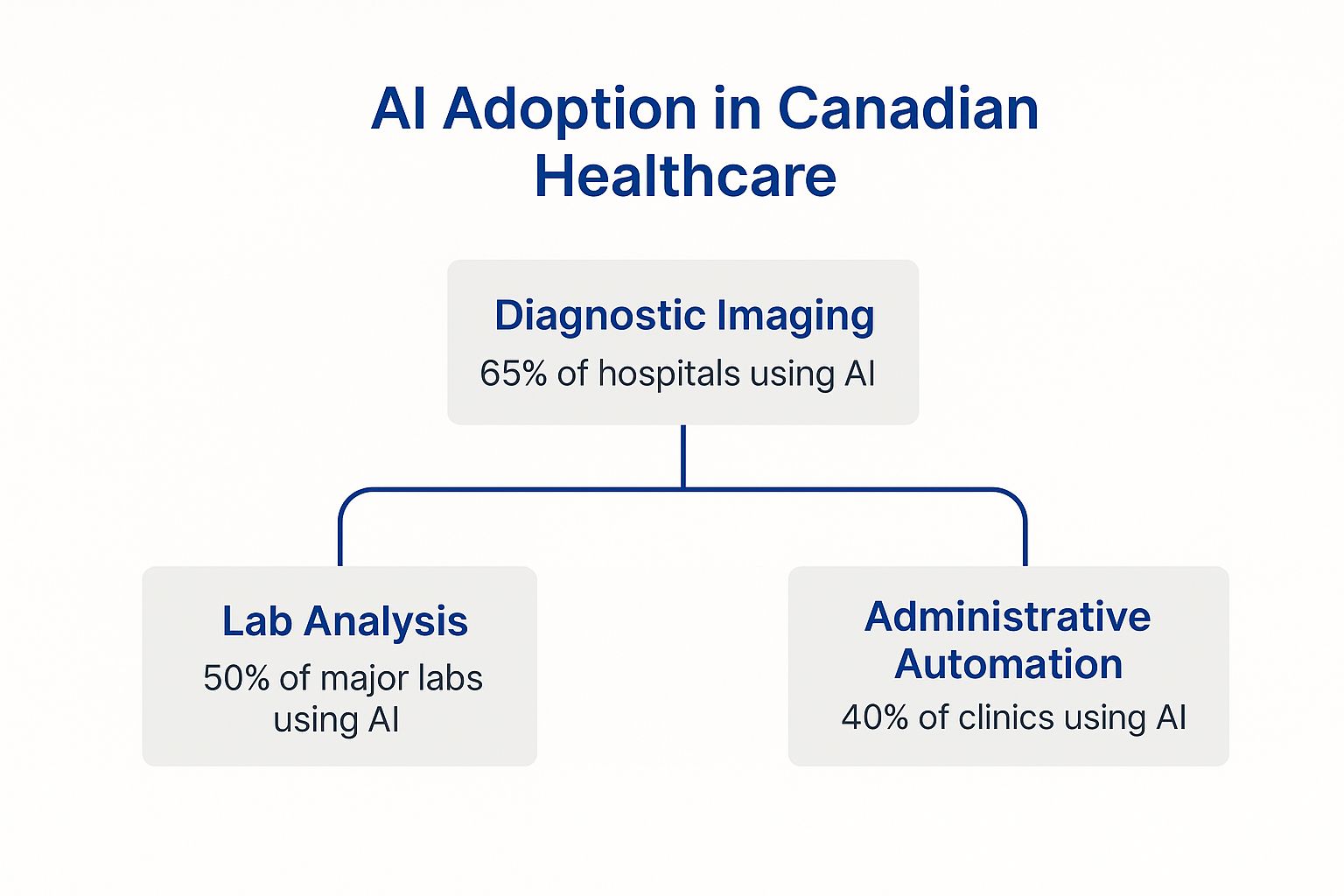
As the data shows, diagnostic imaging is by far the most developed area for AI adoption. This really drives home why having such robust regulatory oversight in this specific field is so essential.
To better understand the key players in this regulatory space, here's a quick breakdown of the main bodies and policies shaping AI in Canadian healthcare.
Key Canadian Regulations and Policies for AI Diagnostics
|
Regulatory Body / Policy |
Governing Level |
Primary Focus |
|---|---|---|
|
Health Canada |
Federal |
Approves all medical devices, including SaMD, ensuring safety and effectiveness before they can be sold in Canada. |
|
Personal Information Protection and Electronic Documents Act (PIPEDA) |
Federal |
Governs how private-sector organizations collect, use, and disclose personal information, which is critical for health data. |
|
Provincial/Territorial Health Ministries |
Provincial |
Oversee the implementation and funding of healthcare services and technologies within their specific jurisdictions. |
|
Provincial Data Privacy Legislation (e.g., PHIPA in Ontario) |
Provincial |
Sets out the rules for the collection, use, and disclosure of personal health information within that province. |
This table shows how different layers of government work together to create a comprehensive system of checks and balances.
The Journey From Code to Clinic
Bringing a new AI diagnostic tool from a brilliant idea to a busy clinic is a long and challenging road. It isn't as simple as writing some code and putting it on the market. Developers have to navigate a tough approval process that demands mountains of documentation, rigorous clinical trials to validate performance, and even post-market surveillance to keep an eye on the tool once it’s in use. This entire journey follows a strict medical device product development process, making sure no corners are cut.
Canada’s regulatory framework isn’t set in stone. It’s designed to be a living system that evolves right alongside technology. This ensures the rules governing AI diagnostics in Canada stay relevant and effective, guiding innovation without strangling it.
At the end of the day, these regulations are about more than just ticking boxes. They form the bedrock of trust for both the public and medical professionals. They give us the confidence that, as technology moves forward, our safety as patients remains the number one priority. To dig deeper into this, it’s worth reading up on the intersection of https://www.cleffex.com/blog/ai-in-healthcare-data-privacy-canada/.
Canadian Success Stories in AI Diagnostics
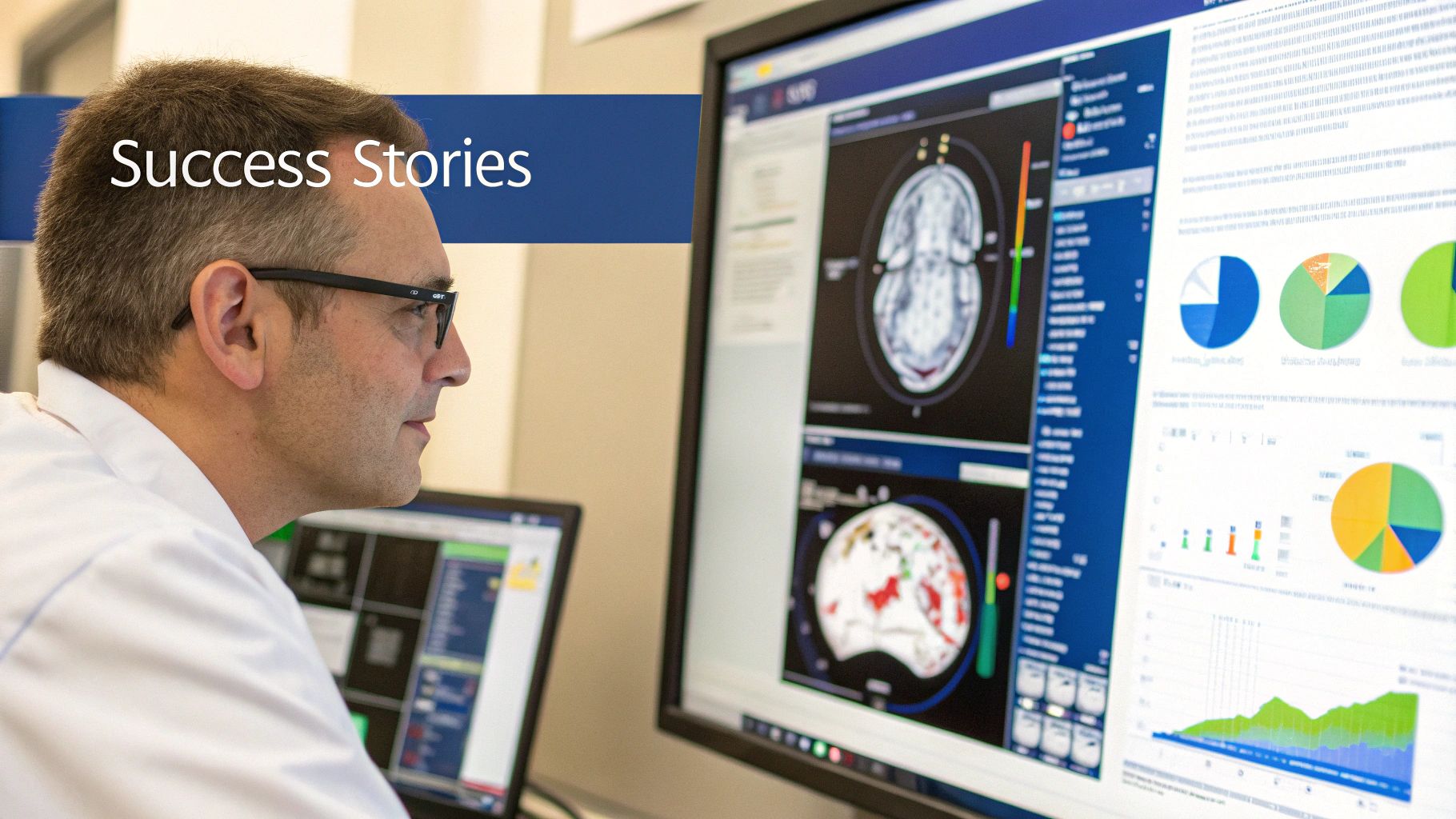
It’s one thing to talk about AI in theory, but it’s in the real world where you can see the difference it makes. Across the country, Canadian companies and research hubs are building practical tools that tackle some of our biggest healthcare challenges. These aren't just isolated experiments; they're solid proof that AI diagnostics in Canada is already making a real impact on patient lives.
Much of this growth stems from national efforts like the Pan-Canadian AI Strategy. By encouraging hospitals, universities, and private companies to work together, we’ve managed to get new technologies out of the lab and into the clinic much faster. This collaborative spirit is what lets innovators take on everything from rare diseases to the long backlogs for common diagnostic tests.
The results speak for themselves. We’re now seeing AI systems that can scrutinize medical images with incredible precision, spotting subtle red flags that even a trained human eye might miss. This means catching diseases earlier, which is almost always the key to better treatment outcomes.
Realizing Measurable Clinical Improvements
The true value of AI becomes clear when you look at the numbers. Canada's investments are paying off with major gains in clinical results and efficiency. In medical imaging, for example, certain AI-backed tools are hitting accuracy rates of over 90%, which is a massive leap forward for early detection.
But it doesn't stop there. In biomedical research, AI's knack for sifting through enormous datasets is slashing the time it takes for drug discovery. That’s a game-changer with huge financial benefits for the pharmaceutical industry. You can read more about some of Canada's recent breakthroughs in AI and healthcare.
The whole point of AI in Canadian healthcare is to support our experts, not replace them. The best tools are the ones that do the heavy lifting, the data crunching, so clinicians can focus on making tough calls and caring for their patients.
This human-plus-machine approach is quickly becoming the new standard.
Spotlighting Canadian Innovation
Several Canadian companies have stepped up to become global leaders, creating specialized AI solutions that are catching on worldwide. These homegrown stories really showcase our country's talent for both top-tier AI research and building things that work in a real hospital setting.
-
Pathology Analysis: Startups in Toronto have built AI platforms that can analyze digital pathology slides, helping pathologists spot cancerous cells faster and more accurately. This means getting biopsy results back to anxious patients sooner.
-
Radiology Workflow: A Vancouver-based company created an AI tool that smartly triages medical imaging queues. It automatically flags urgent cases, like potential brain bleeds, to push them to the front of the line for a radiologist's review.
-
Genomic Medicine: Researchers in Montreal are applying AI to genomic data to pinpoint genetic markers for various diseases. This is paving the way for truly personalized treatment plans.
And that's just a snapshot of what’s happening. The trend is clear: AI diagnostics in Canada is no longer just a concept. It’s delivering real value by enabling faster diagnoses, reducing costs, and ultimately, improving patient care for everyone.
Building Trust and Navigating the Human Side of AI
For all its promise, bringing AI diagnostics into mainstream Canadian healthcare isn't just a technical challenge. The biggest hurdle we face isn't about algorithms or processing power; it's about people. Clinicians and patients alike are understandably cautious, and that skepticism needs to be taken seriously.
This natural hesitation creates a "trust gap." On one side, you have medical professionals worried about what these tools mean for their professional autonomy and job security. They’ve spent their careers honing their diagnostic skills, and the idea of an algorithm taking over, or worse, making a mistake they're responsible for, is a major concern.
On the other side are the patients. For them, the worries hit closer to home. They have legitimate questions about the privacy of their health data and whether the AI making recommendations is truly fair and unbiased.
It’s More Than Just a Software Update
Getting this right means thinking beyond the technology. We need a thoughtful, human-centred approach to integrating these tools into the clinic. Building genuine confidence is the name of the game.
Research from Philips in 2025 highlighted this exact issue, pointing to a significant trust gap among both healthcare professionals and patients. This isn't just an abstract problem; it has real-world consequences. With nearly half (45%) of Canadian patients facing long waits for appointments and 27% reporting their health has declined as a result, AI is a tool that could help. But it can only work if people trust it. You can dive deeper into these findings on how AI can address healthcare system pressures.
To bridge this trust gap, we need to focus our attention on three key areas:
-
Tackling Algorithmic Bias: This is a huge one. An AI model trained primarily on data from one specific demographic might not work as well for others. We have an ethical and medical obligation to ensure these diagnostic tools are equitable and fair for every Canadian.
-
Integrating AI into the Workflow: AI should be framed as a powerful partner, not a replacement. Think of it as a highly skilled assistant that crunches the data, freeing up clinicians to do what they do best: focus on their patients, handle complex cases, and make the final call.
-
Opening the "Black Box": For a doctor to trust a recommendation, they need to understand how the AI reached its conclusion. We need transparency. Similarly, patients have a right to know how AI is being used in their care, and it needs to be explained in plain language.
Ultimately, getting AI adoption right is less about technological brilliance and more about building a solid foundation of trust. That foundation is built with clear communication, thorough education for clinicians, and unwavering ethical guidelines that always put the patient first.
Answering Your Questions About AI Diagnostics in Canada
As AI diagnostic tools find their way into Canadian clinics and hospitals, it’s only natural for questions and concerns to pop up. Let's tackle some of the most common ones.
The big question on everyone's mind is usually about safety. Are these tools actually regulated? Absolutely. In Canada, AI diagnostic software is treated as a medical device and falls under the strict oversight of Health Canada. Before any AI tool gets near a patient, it has to go through a tough, risk-based review process to prove it’s both safe and effective. The higher the risk, the more intense the scrutiny.
Another common worry is whether AI will put doctors out of a job. The simple answer is no. It’s about collaboration, not replacement. Think of it this way: AI is like an incredibly powerful assistant that can sift through mountains of data and catch subtle patterns a human might miss. This frees up our amazing doctors to do what they do best: handle complex decisions, connect with patients, and craft personalized treatment plans. The tech makes our experts even better.
How is Patient Privacy Protected?
With all this data being analyzed, what happens to patient privacy? This is, without a doubt, a top priority.
Protecting personal health information is non-negotiable. Canada has a strong legal shield in place, with federal and provincial privacy laws like PIPEDA setting the rules. Any healthcare organisation using AI has to follow very strict protocols.
-
Data Anonymization: This involves stripping away all personal identifiers from the data, making it impossible to trace back to an individual.
-
Strong Encryption: Data is scrambled and secured, both when it's sitting on a server and when it's being sent from one place to another.
It all comes down to trust and transparency. Patients have every right to know how their information is being used, and these frameworks make sure that AI diagnostics in Canada always puts patient confidentiality first.
Ready to see how custom AI solutions can support your organisation? At Cleffex Digital Ltd, we build secure, compliant, and intelligent software to solve today's biggest healthcare challenges. Learn more at https://www.cleffex.com.
